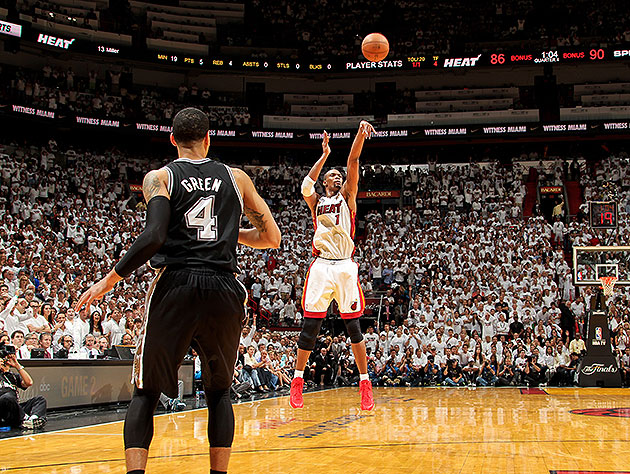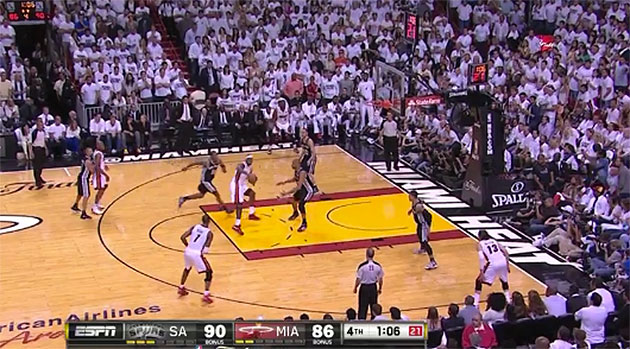
Heading into the NBA Finals, a number of analysts suggested that, with all due respect to the San Antonio Spurs, a Miami Heat offense that struggled mightily at times in the Eastern Conference finals would hit its stride after dispatching the Indiana Pacers' brutal defense.
"Chris Bosh in particular would feel like he's getting out of jail," TNT commentator Steve Kerr told USA TODAY Sports' Jeff Zillgitt, due to the "more free-flowing" and less physical nature of the game the Spurs like to play ("They don't beat you up").
Reasonable folks can differ as to whether San Antonio beats you up — if nothing else, they do seem to step on your head — but one thing's for sure: the Spurs sure didn't mind letting Bosh be a free man when it suited them.
The most obvious case came with just over a minute left in the fourth quarter and the Spurs leading 90-86. You remember — LeBron James dribbles up the court and gets a high screen on Kawhi Leonard from Ray Allen. Tony Parker offers sort of a half-hedge that James easily dribbles around on a drive to the lane. As James enters the paint, Tim Duncan slides over to meet him, leaving Bosh all alone beyond the arc on the right wing. Bosh rises, fires ...
... and misses. Danny Green grabs the rebound, calls timeout and secures possession with less than 60 seconds left. It didn't ice the game (some Tony Parker magic would do that) and it wasn't one of the highest-impact plays of the game (at least, not according to NBA.com's win probability measurements), but coming up empty there hurt Miami and helped San Antonio hang on for a 92-88 Game 1 win.
After the game, Heat coach Erik Spoelstra was asked whether he'd drawn up Bosh's long-range try, the big man's fourth 3 of the night, all unsuccessful.
"We had an opportunity to get into the paint. He was open," Spoelstra said. "Probably open for a reason at that point. But we had a couple of different options, triggers to get guys into the paint or to get into another situation."
And, of course, he was open for a reason. While Bosh did extend his range out to 3-point distance this season, going 21 for 74 (28.7 percent) from deep, and has been on a hot long-range shooting kick this postseason — 15 for 31 (48.4 percent) from 3 in the playoffs, including 9 for 17 (52.1 percent) above the break — the Spurs were way less concerned about him taking an open shot from the wing than they were about the other things that could have happened on that play.

The most dangerous option, obviously, is James driving for a layup. That's why Duncan slides over to stop the ball, why Leonard is racing back after being screened by Allen, and why Manu Ginobili has his left foot in the paint sagging off Dwyane Wade in the weak-side corner.
"When I got the ball, they kind of shrunk the floor and set a guy at the elbow and dared me to pass the ball," James said. "I know my guys will be there to knock those shots down the next game."
Ginobili can also get away with sinking a little further than normal because Wade's hit 25.7 percent of his 3s this year and has attempted only 11 from the corners in 85 regular- and postseason games. And, of course, Allen's a threat any time he's beyond the arc, which is why Parker stays stuck to him after the completion of the high screen.
But Wade and Allen are on the weak side of the play, and James is both driving and looking right, which makes the two most viable outlet options Bosh on the wing and Mike Miller in the strong-side corner. Miller wasn't quite as potent from the short corners this year as he was during the 2011-12 regular season (44.7 percent) or postseason (43.8 percent), but he still hit corner triples at a 37.5 percent clip and has a very quick release; that's why Green's staying within very close hailing distance.
Go back to the video up top and run it back, and you'll see Green instinctively begin to rotate toward the wide-open Bosh when James makes the pass, then stop in his tracks and stay put. This is the realization of game-plan implementation, tons of defensive drilling and the communication of a simple philosophy: We'd rather let a decent 3-point shooter take an open shot above the break than an excellent 3-point shooter take an open shot from the corner.
The Spurs showed a similar willingness to let Bosh cast off from just about the same spot earlier in the fourth quarter, following a right-side pick-and-pop with James:
After Bosh sets the screen, Leonard and Duncan converge to harass James and attempt to hem him in at the right mid-block. Bosh pops into space, James hits him with a neat little behind-the-back bounce pass, and Bosh has enough room to let it fly ... but again comes up short.
And again, let's take a look at what the defense is thinking in that moment:

Ginobili, again, is shading toward the strong side because he's not sweating Wade above the arc. Parker's splitting the difference between the ball and Norris Cole in the weak corner, who he's got to be aware of, but doesn't have to worry a *ton* about given the distance between Bosh and Cole (and the relative unlikelihood of Bosh making that pass). Leonard's with James, naturally, and Gary Neal's got to stay on the greatest 3-point shooter of all time in the near corner.
That just leaves Duncan and Bosh, and while Duncan instinctively begins to rotate to his man to take away the open shot, he stops himself at the elbow. Even in a one-point game, Bosh, from there, Duncan will have to live with; he's better served retreating to the glass to be able to finish the defensive possession with a rebound in the event of a miss, which is exactly what happens.
So yes, Bosh was "probably open for a reason," and a pretty good one, at that. Still, Spoelstra wasn't about to pin the loss on Bosh's late miss.
"You know what, we'll take that shot," Spoelstra said. "He's been making those. It's an open shot in the fourth quarter. It didn't come down to that. There were more plays going down the stretch. Turnovers, random possessions where we didn't get to where we wanted to like that. We didn't get the shots that we wanted to. And some of those loose balls, offensive rebounds in the fourth quarter really hurt."
Spoelstra's right, of course — five Miami turnovers in the fourth quarter that turned into six Spurs points were killers, as were two Duncan offensive rebounds that led to five Spurs points in the final 5 1/2 minutes, including a huge 3 by Green that gave San Antonio a seven-point lead with 2:13 remaining. Ditto for several missed second-half layups by Wade, eight missed corner 3s, an inability to consistently and effectively trap the Spurs' pick-and-rolls and plenty of other things.
Bosh's four missed 3-pointers hurt, though, and, as all things seem to, drew a perhaps disproportionate amount of vitriol toward the Heat's third banana.
Not that going 0 for 4 from 3-point range, 1 for 5 from the floor in the fourth quarter or 6 for 16 overall in Game 1 seemed to shake the big man's confidence much.
“It's a part of sports," Bosh said after Game 1, according to CBSSports.com's Zach Harper. "You really don't have time to think about it. You just react and that's something I always lived by no matter what the situation is. I have confidence in myself and I know my teammates have confidence in me, and every shot that I shoot I expect it to go in. Some do and some don't."
And given how well Bosh has been shooting from deep this postseason — and for as much as he struggled against the Pacers, he shot 58.3 percent on above-the-break 3s in the Eastern finals — it's understandable that he'd feel that level of confidence. Still, this playoff push beyond the arc is kind of strange.
As Trey Kerby of The Basketball Jones noted, Game 1 marked the fourth time this postseason that Bosh has shot four or more 3-pointers in a single game, which is something he'd only done once in his career before the start of the playoffs. And he's taking those 3s rather than popping long 2-pointers or working the midrange game ... which we'd normally consider a good thing from an offensive efficiency perspective, except that Bosh is arguably the best midrange-shooting big man in the NBA. He shot 50.2 percent on midrange jumpers during the regular season and well over 40 percent in each of the first two rounds before a cold snap against the Pacers. He was money on Thursday, too, going 5 for 8 from midrange and 1 for 8 from everywhere else.
No one disputes that Bosh's ability to step out on the floor is a critical element in the Heat's five-out sets, drawing opposing big men out of the paint and providing key floor-spacing that allows James, Wade and point guards Mario Chalmers and Norris Cole to find lanes to penetrate, collapse the defense and kick out to open shooters. But given how good Bosh is from midrange, how the Heat's sets almost always plant a more dangerous shooter alongside Bosh in the strong-side corner, and how the Spurs have decided they will force Bosh to beat them with that shot, might he be better served — in defiance of all we know about crafting an efficient offense — taking a step or two in and firing from 20 feet instead of 23 feet, 9 inches?
Wherever the launching point, James told reporters at Friday's practice that if the same plays happen in the same fashion in the same area of the court in Game 2 on Sunday, he won't hesitate to make the same reads and the same feeds.
"I found CB for four really good looks that he missed, that he's capable of making," James said. "My guys are open. I've got this far with them, I'm not going to just abandon what I've been doing all year to help us get to this point. So I know those guys will be ready to shoot again once they're open."
Bosh sure will.
"Life is about being in the hole sometimes," Bosh said after the game, according to Tim Reynolds of The Associated Press. "You either stay in the hole or dig your way out."
Or, put another way: Shooters keep shooting.
No comments:
Post a Comment